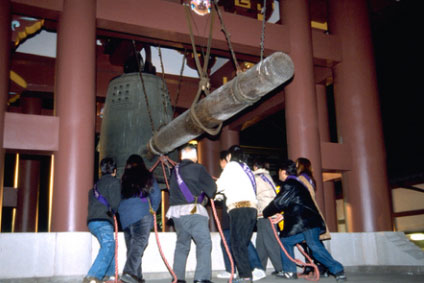
A group of people striking a temple bell in a Buddhist ceremony at midnight on New Year's eve (joya no kane). The bell is struck exactly 108 times to signify the washing away of the 108 polluting earthly desires in the Buddhist religion. (Source: TJF)
You must keep in mind that fluency in Japanese (or any foreign language) does not happen over night. It may seem to be a very slow process to you but it is one that is achieved the more you practice and seek ways to use your new skills.
In Time you will:
- talk about time
- talk about places in a town
- talk about things to do in school
- talk about things you do at different places in town
- learn to ask yes/no and information questions
- learn more numbers, until 100
- learn about an old capital city of Japan, Kyoto
- learn to give feedback in communication
- practice typing in hiragana
As you work, keep in mind the symbols that will help you to remember what it is you are going to be doing throughout the course. If you have forgotten those, you can look back at them to keep them in mind.
By Oren Rozen [CC BY-SA 4.0 ], from Wikimedia Commons
![]() Topics and Study Time
Topics and Study Time
You should keep in mind that during the course of this unit you should spend time doing the following daily:
- At least 15 minutes daily vocabulary activities, drilling vocabulary (flashcards).
- Practicing hiragana.
- Going back to review any vocabulary from previous units as a warm-up activity.
![]() Graded Assignments will have the checkmark icon next to the title.
Graded Assignments will have the checkmark icon next to the title.
To locate the most current assignment instructions and to submit your completed work, please go to your Section Assignments folders in Schoology. You will complete the following types of graded assignments in this unit:
- Grammar Notes
- Oral Assignments
- Writing Assignments
- Discussion Assignments
- Speaking Assignments
- Section Quizzes
- TPR Quizzes
- Unit Exam
